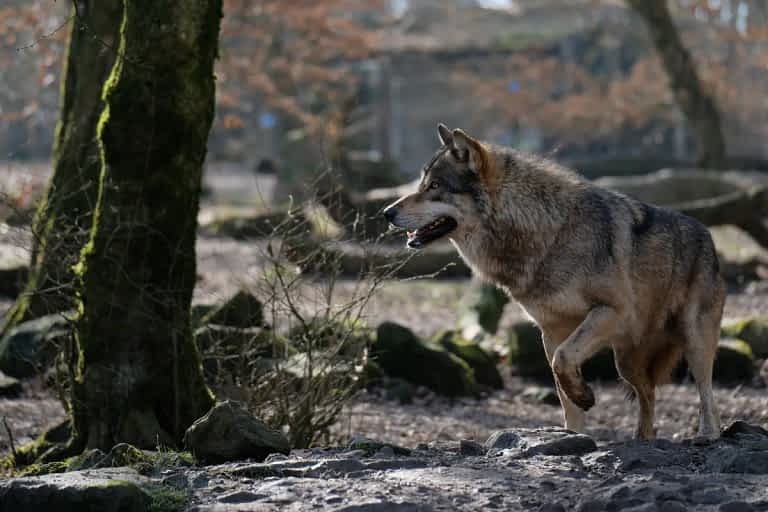Tervuren’s 32.92 km² (3,292 hectares) of land boasts a significant forested expanse for wolves, including the Arboretum of Tervuren and sections of the Sonian Forest such as the Kapucijnenbos. As wolves make their cautious return to Flanders, these lush, tree-covered stretches could serve as prime territory for the elusive predators.
No need to be afraid. “They see us as formidable competitors, as fellow hunters. But also as the ones who wiped them out. So, they have a deep-rooted aversion to humans.”
Historical Significance and Wolf Habitats
A word of advice: Wolves should not be cornered. “If you trap a wolf in your garden, it will bite arms and legs to escape. But wolves will never attack humans as prey.”
“So, you should never fear wolves. But for people with sheep, ponies, and goats, that’s a different story, of course,” Loos acknowledges.
The wolf’s return is not just an ecological milestone—it also holds historical significance for Tervuren. Is that symbolism reflected in the Wolvenweg? “The name might actually come from ‘knotwillige weg,’ a corruption of a dialect word for ‘pollard willow.’ It’s not certain that it refers to wolves,” Loos explains.
What is certain, however, is that the last documented wolf in the area was killed by villagers in the late 18th century, marking the species’ eradication from Tervuren.
Von der Leyen, Tervuren, and Wolves
While conservationists like Loos celebrate the wolf’s return, Tervuren’s famous former resident has waged a battle against the species. Ursula von der Leyen, President of the European Commission, suffered immense personal loss when her beloved pony, Dolly, was killed by a wolf identified as GW950m. Since then, she has successfully advocated for downgrading the wolf’s protected status in the EU. Loos questions whether personal motives influenced this policy. “Tervuren should certainly not make her an honorary citizen,” he says.
Loos also calls for an end to the culling of wild boar in Tervuren. “There’s no food. The moment some wild boar appear, they are immediately shot. If no wild prey is available, wolves will turn to livestock. For them, it’s just food. It may be less tasty, but it’s much easier to catch.” He launched a petition at https://welkomwolf.be/petitie/ urging stronger safeguards, backed by thousands of signatures.
Why is Welkom Wolf taking the Flemish government to court?
Welkom Wolf and the conservation association Landschap vzw have filed a lawsuit to force the Flemish government to comply with European rules on wolf protection.
Their petition calls for immediate measures such as roadside fencing and speed limits to prevent wildlife collisions, the rapid construction of wildlife crossings over the N74 and N76, a comprehensive wolf protection plan with specific territorial objectives, a ban on roe deer hunting in the wolf’s core areas, the removal of migration barriers, and an open procedure for any exemption to the ban on capturing or killing protected species.
More information:
https://welkomwolf.be/wolvenzaak/
Exclusive Wolf Stage in Germany
Dates: Sunday, 5 October 2025 – Thursday, 9 October 2025
Location: Dresden, Lausitz region, birthplace of the German wolf population
Organisers: Landschap vzw & Starling Natuurreizen
Highlights:
- Maximum of 7 participants for personalised guidance. Expert-led sessions with top local guides and mammal specialist Frederik Thoelen. Quality accommodation and transport provided. Two travel days and three full days of fieldwork with real wolf experts
Activities include:
- Tracking wolf signs and learning to identify them. Studying wolf prey and monitoring techniques. Installing and checking camera traps. Lectures on the latest developments in the wolf population. Possibly spotting a wild wolf in its natural habitat
Accommodation: Stay in a cozy three-star guesthouse located in the heart of wolf territory, providing rooms and meals during the stage.
Climate & Clothing: Prepare for variable weather conditions in October. Bring warm, waterproof clothing and sturdy, waterproof hiking boots. A warm hat, scarf, and gloves are advisable.
For more details and registration, visit Landschap vzw – Exclusive Wolf Stage in Germany.
Author: Dafydd ab Iago. © Article and photos licensed © 2024 for Tervuren+ under the Attribution-ShareAlike 4.0 International license.
